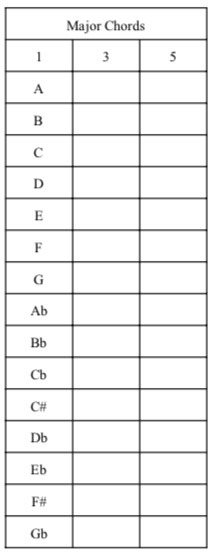Here are the correct notes to the major scales. Hopefully you found the right answers and can understand any corrections you need to make. Your best bet now is to print out this sheet and throw away the handwritten one so you for sure have every note listed correctly.
Our next step is going to be using these major scales to build CHORDS. If you found the major scales to be difficult to build, I think that building chords to be easier. Let me explain.
The first thing we need to do look at the bottom of the completed major scales page and notice the numbers. These are the SCALE DEGREES. In the A major scale the 2nd note is B (AKA scale degree 2).
In the G scale, scale degree 7 is F#.
The first chord we will investigate is the MAJOR TRIAD aka MAJOR CHORD. The major triad has 3 notes and beautiful. To build any major triad, start on any scale degree 1 (the left most column of the page) and add scale degree 3 and scale degree 5. For example, the A major triad is A, C#, and E. The Eb major triad is Eb, G, Bb.
All that work on writing out the major scales makes this part much easier. Write in all the major triads you can figure out and then let’s put them to use. Can you find any of the triads on your instrument. They can be played together or separately in any order. For example C major triad = C E G. Playing C E E G E E G C C one-at-a-time is a creative use of C major triad! F# major triad= F# A# C#.
If your instrument allows it you can play all of them together. Even start playing C major triad and then move onto F# major triad and then go back and forth. C E G G C G -> A# C# C# F# -> E E C
I picked these 2 chords because they are extremely different and don’t blend well together. I want you to try other combinations of chords (notes together or separate) and find combinations that make you smile. Theory explains music but their are NO RULES! Make some music and we’ll tackle the MINOR TRIAD next lesson.


